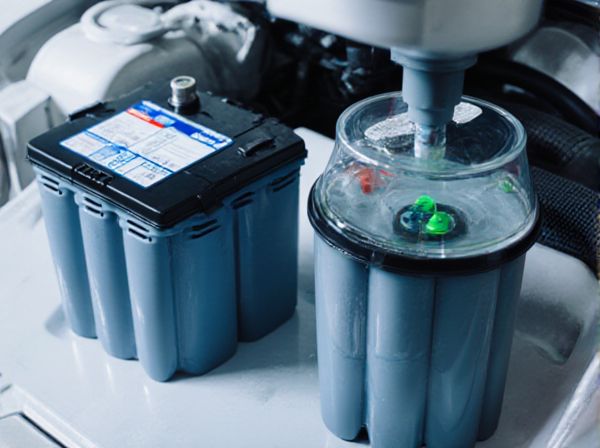
Photo illustration: Dry Cell vs Wet Cell
Dry cells contain a paste electrolyte, making them leak-resistant and suitable for portable devices, while wet cells use a liquid electrolyte and are commonly found in automotive batteries due to their ability to deliver high current. Your choice depends on the application; dry cells are ideal for low-drain devices, whereas wet cells offer better performance for high-drain, heavy-duty uses. Understanding these differences ensures you select the battery type that maximizes efficiency and safety.
Table of Comparison
| Feature | Dry Cell Battery | Wet Cell Battery |
|---|---|---|
| Electrolyte | Gel or paste | Liquid (acidic solution) |
| Maintenance | Maintenance-free | Requires regular electrolyte checks |
| Leakage Risk | Low | High |
| Weight | Lighter | Heavier |
| Durability | Better vibration resistance | Less resistant to vibration |
| Cost | Higher upfront cost | Lower initial cost |
| Common Use | Modern cars, motorcycles | Older vehicles, deep cycle use |
Introduction to Dry Cell and Wet Cell Batteries
Dry cell batteries contain a paste electrolyte that minimizes leakage and allows for compact, portable power sources commonly used in household devices. Wet cell batteries, utilizing a liquid electrolyte, provide reliable high-capacity energy storage ideal for automotive and industrial applications. Both types convert chemical energy into electrical energy but differ significantly in construction, maintenance, and usage scenarios.
Key Differences Between Dry and Wet Cells
Dry cells use a paste electrolyte, making them more portable and less prone to leakage, while wet cells contain a liquid electrolyte, which can spill and require maintenance. Dry cells typically have lower voltage capacity and are commonly used in household devices, whereas wet cells provide higher voltage and are preferred in automotive and industrial applications. The sealed design of dry cells enhances safety and convenience, contrasting with the open structure and heavier weight of wet cells.
Components and Construction
Dry cells use a solid or paste electrolyte, typically consisting of ammonium chloride or zinc chloride, enclosed within a zinc container that acts as the anode. Wet cells contain a liquid electrolyte, often sulfuric acid or a similar conductive solution, housed in separate compartments with electrodes immersed directly in the fluid. The construction of dry cells emphasizes portability and leak-resistance, while wet cells prioritize high current output and ease of electrolyte maintenance.
How Dry Cells Work
Dry cells operate using a paste electrolyte, which allows them to function in any orientation without leaking. The chemical reaction between the zinc anode and the manganese dioxide cathode generates electrical energy. This design ensures compactness, portability, and safety, making dry cells ideal for everyday portable devices.
How Wet Cells Work
Wet cells operate through electrochemical reactions between liquid electrolytes and metal electrodes, allowing ions to flow freely and generate electric current. The liquid electrolyte typically consists of sulfuric acid or ammonium chloride, enhancing ionic conductivity and efficient charge transfer. Commonly used in automotive batteries, wet cells provide high current output and reliable performance for starting engines and powering heavy-duty applications.
Advantages of Dry Cell Batteries
Dry cell batteries offer significant advantages such as portability and leak resistance, making them ideal for use in portable electronic devices and remote locations. Their sealed design prevents electrolyte leakage, enhancing safety compared to wet cell batteries that contain liquid electrolytes prone to spills. Moreover, dry cells typically require less maintenance and perform reliably in various orientations and environments, supporting consistent power delivery.
Advantages of Wet Cell Batteries
Wet cell batteries offer a higher capacity for energy storage compared to dry cell batteries, making them ideal for applications requiring long-duration power. They provide excellent rechargeability and durability, suitable for automotive and backup power systems. The liquid electrolyte in wet cells allows better ion flow, resulting in improved efficiency and longer battery life.
Common Applications of Each Type
Dry cells are commonly used in portable electronic devices such as flashlights, remote controls, and handheld gadgets due to their sealed design and spill-proof nature. Wet cells are frequently found in automotive batteries, uninterruptible power supplies (UPS), and large-scale industrial applications where higher power capacity and rechargeability are essential. The choice between dry and wet cells depends on factors like mobility, maintenance requirements, and energy demands specific to each application.
Safety and Maintenance Considerations
Dry cells offer enhanced safety due to their sealed design, which minimizes leakage and reduces the risk of acid spills or corrosion, making them ideal for portable devices and indoor use. Wet cells require regular maintenance such as electrolyte level checks and top-offs to prevent damage, and they pose higher hazards from acid exposure and potential leaks. Proper handling and routine inspections in wet cells are crucial to ensure safe operation and prolong battery lifespan.
Choosing the Right Battery: Dry Cell vs Wet Cell
Choosing the right battery depends on application requirements such as energy density, maintenance, and safety. Dry cells offer leak-proof, portable power ideal for small electronics, while wet cells provide higher capacity and rechargeability suited for automotive and backup systems. Consider factors like voltage output, lifespan, and environmental conditions to select between dry cell and wet cell batteries effectively.
 caratoz.com
caratoz.com